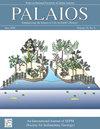德克萨斯州中部海湾沿岸平原古新世-始新世边界植物群落变化
IF 1.5
4区 地球科学
Q2 GEOLOGY
引用次数: 0
摘要
古近纪早期的长期全球变暖被几个短期的“过热”事件所打断,其中最显著的是古新世-始新世极热期(PETM)。在这个长期的变暖过程中,热带气候扩展到热带以外的地区,形成了一个广泛的嗜热植物群带,延伸到副热带地区,在某些地区可能远至北美中纬度地区。尽管这些亚热带植物分布在北美海湾沿岸平原,但人们对它们的了解相对较少。我们评估了古新世-始新世边界前后德克萨斯州中部墨西哥湾沿岸平原的植物区系,以确定该地区与快速全球变暖相关的植物生态系统变化。在古新世-始新世界线之后,这些植物区系表明墨西哥湾沿岸平原的植物群落是统一的,但具有较高的更替率和群落组成的变化。德克萨斯州中部古新世和始新世植物区系的古生态和古气候评价表明,该区环境温暖湿润,具有热带季节性森林到热带雨林生物群落的特征。来自墨西哥湾沿岸平原和怀俄明州大角盆地的化石证据表明,古近纪早期的变暖有助于形成一条延伸到中纬度地区的副热带带。评估化石植物群落对快速全球变暖的响应对理解和应对当前全球变暖和气候变化具有重要意义。本文章由计算机程序翻译,如有差异,请以英文原文为准。
PLANT COMMUNITY CHANGE ACROSS THE PALEOCENE–EOCENE BOUNDARY IN THE GULF COASTAL PLAIN, CENTRAL TEXAS
Abstract Long-term global warming during the early Paleogene was punctuated by several short-term ‘hyperthermal’ events, the most pronounced being the Paleocene–Eocene Thermal Maximum (PETM). During this long-term warming, tropical climates expanded into extra-tropical areas, creating a widespread band of thermophilic flora that reached into the paratropics, possibly as far north as mid-latitude North America in some regions. Relatively little is known about these paratropical floras, despite distribution across the North American Gulf Coastal Plain. We assess floras from the Gulf Coastal Plain in Central Texas before and after the Paleocene–Eocene boundary to define plant ecosystem changes associated with rapid global warming in this region. After the Paleocene–Eocene boundary, these floras suggest uniform plant communities across the Gulf Coastal Plain, but with high turnover rate and changes in community composition. Paleoecology and paleoclimate assessments from Central Texas Paleocene and Eocene floras suggest a warm and wet environment, indicative of tropical seasonal forest to tropical rainforest biomes. Fossil evidence from the Gulf Coastal Plain combined with the Bighorn Basin, Wyoming data suggest that early Paleogene warming helped create a paratropical belt that extended into mid-latitudes. Evaluating the response of fossil plant communities to rapid global warming has important implications for understanding and preparing for current global warming and climate change.
求助全文
通过发布文献求助,成功后即可免费获取论文全文。
去求助
来源期刊

Palaios
地学-地质学
CiteScore
2.80
自引率
12.50%
发文量
40
审稿时长
6 months
期刊介绍:
PALAIOS is a monthly journal, founded in 1986, dedicated to emphasizing the impact of life on Earth''s history as recorded in the paleontological and sedimentological records. PALAIOS disseminates information to an international spectrum of geologists and biologists interested in a broad range of topics, including, but not limited to, biogeochemistry, ichnology, paleoclimatology, paleoecology, paleoceanography, sedimentology, stratigraphy, geomicrobiology, paleobiogeochemistry, and astrobiology.
PALAIOS publishes original papers that emphasize using paleontology to answer important geological and biological questions that further our understanding of Earth history. Accordingly, manuscripts whose subject matter and conclusions have broader geologic implications are much more likely to be selected for publication. Given that the purpose of PALAIOS is to generate enthusiasm for paleontology among a broad spectrum of readers, the editors request the following: titles that generate immediate interest; abstracts that emphasize important conclusions; illustrations of professional caliber used in place of words; and lively, yet scholarly, text.
 求助内容:
求助内容: 应助结果提醒方式:
应助结果提醒方式:


